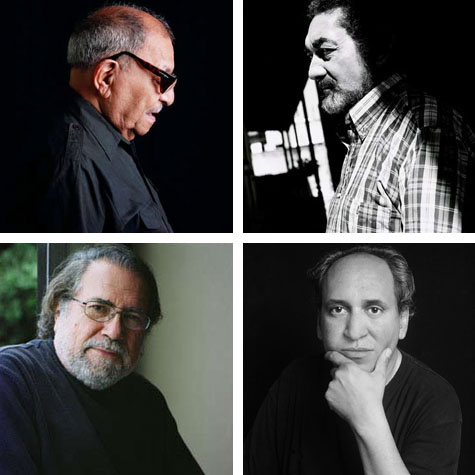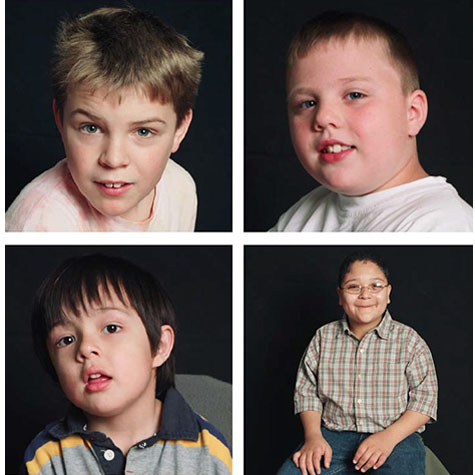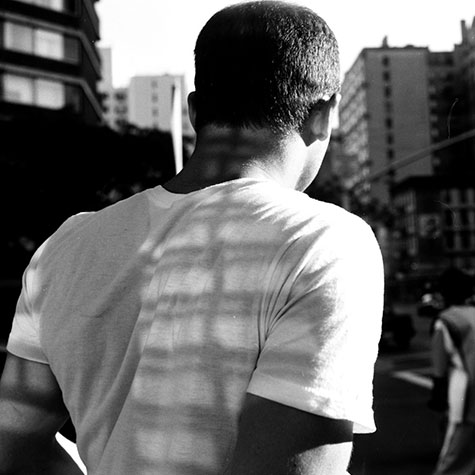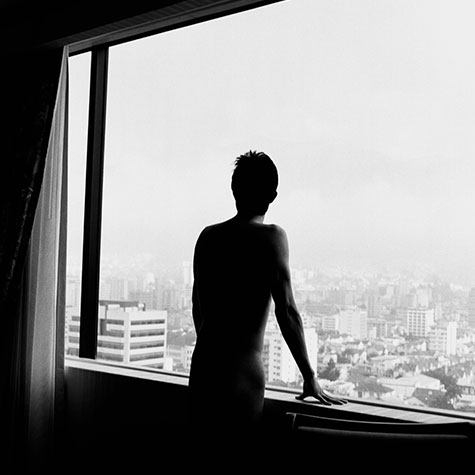REBECCA ZILENZIGER
translation by María Angélica Fernández
(ver version en español)
The Un-choreography of One Light
It is said that two people exist in every portrait, the subject and the photographer. Portrait photography has been noted and even celebrated for this tension. But the duality can serve to undermine the singular intent specific to portraiture: the depiction of an individual.
Swiss/American portrait photographer Rebecca Zilenziger has worked out of her studio and darkroom in Old San Juan, Puerto Rico for sixteen years. Through travel and studio work, her photographic projects range from natural disasters and mental disorders, to construction sites and obscure or well-known cultural figures. By refusing to place herself at the center of her work, Zilenziger has amassed a body of images that reevaluate cultural perception, with the intent of making people see things in ways they haven’t before.
For the series of images on children with autism, the use of one light became a fulcrum for interaction in the studio. In this series, shot in Providence, Rhode Island, Zilenziger worked at a behavioral center that associates child management to developmental research. The project demanded a proposal, a slew of releases, support from clinical staff, and several trips to the area.
The notion of disconnection constrains professional and parental advocacy for children with autism. But when the children entered the room, the one light became a point for their attention. Each image in the series depicts very real and very direct moments of eye contact. Research to this day strives forward to contextualize autism within the diversity of functioning human behaviors. Zilenziger represented children with autism in a visual accuracy, free of the glut of processed information that manipulates facts and subtleties to its own accord.
 |
 |
Zilenziger’s images of significant and historic Puerto Rican artists came from a simple search for a concise book on the subject, “to see their faces,” she said. By and by, Zilenziger found that no such book exists. She consequently sought out and photographed Puerto Rican artists by going to their homes and studios, or inviting them to hers. Each artist in the series is significant, their work is on display at museums, they have earned gallery representation, and are widely collected. A concern over the inability to identify the faces of Puerto Rican artists is evident in the series itself. Each artist takes up the photograph in its entirety. The area surrounding the artist is out of focus, obscured, and made unimportant. In an effort to connect the viewer to the individual, nothing else distracts the introduction – an introduction Zilenziger makes immediate.
This series of Puerto Rican artists is emblematic of a larger issue that the art world and the public contend with: if the name, the work and the face of the artist are not in concert with one another, then the artist and their work is marginalized. As with most Latin American art and culture, the borders of recognition have been heavily policed.
Photographers lovingly use three, four, even five lights or more. And though their work might be incredibly eye catching, there is a glitz that verges on the grotesque with its curtsy to advertising. Zilenziger is not subtle about her dislike of over-illumination, and she uses either natural sunlight or a monolight Swiss-made Elinchrom, and never at the same time. Her one light serves as a focus point – without any visual roadblocks that clutter or congest viewer access or over produce the image with artificiality. Zilenziger presents individuals emerging from their own natural shadows.
Countless portrait photographers insert themselves into the images they produce. Annie Leibovitz favors the choreography of public celebrity over the private persona of her subjects. Diane Arbus attacked the concept of “proper” art through her work. Richard Avedon’s portraits were said to be first and last Avedon’s. And while these intimate motives and meanings are vital to the evolution of photographic portrait art, the mimetic repetition of technique has reduced portraiture to the personality of the photographer.
Today, the rogue portrait photographer is one who refuses to place themselves anywhere except behind the camera. Rather than congest the image with ulterior motives, they allow the photograph to focus in on its subject. As a portrait functions to honor and remember, Zilenziger remembers to honor the function of the portrait.
 |
 |
FOTOGRAFÍA DEL RETRATO
por Ashley Mercado en conversación con la fotógrafa
REBECCA ZILENZIGER
traducido por María Angélica Fernández
La no-coreografía de una sola luz
Se dice que en cada retrato existen dos personas: el sujeto y el fotógrafo. El retrato fotográfico se ha conocido y
hasta celebrado, por esta tensión. Pero la dualidad puede servir para socavar este singular y específico propósito del
retratismo: la representación de un individuo.
La fotógrafo suiza-americana Rebecca Zilenziger ha trabajado desde su estudio y cuarto oscuro en el Viejo San Juan,
Puerto Rico durante dieciséis años. Desde fotos de viaje y de estudio, sus proyectos fotográficos van de desastres
naturales y desórdenes mentales a solares en construcción y figuras culturales anónimas o conocidas. Rehusando
colocarse en el centro de su trabajo, Zilenziger ha acumulado un cuerpo de imágenes que re-evalúan la percepción
cultural, con la intención de que la gente vea las cosas de maneras no vistas antes.
Los niños autistas padecen a causa de los supuestos sobre su conducta, al igual que los artistas latinoamericanos o hispanos continúan sufriendo la oscuridad. En ambas instancias, hay una verdad no reconocida. En cada fotografía el individuo observa desde el fondo de sus ojos su propia experiencia de vida, o coloca su cuerpo en la comodidad de su propia disposición. Las fotos de Zilenziger muestran el “desorden” como una percepción social en vez de la condición de autismo o la circunstancia de oscuridad. Las imágenes no están manchadas por una opinión, sino representadas en un único momento de realidad particular.
Innumerables fotógrafos de retratos se insertan en las imágenes que producen. Annie Leibovitz prefiere la coreografía de persona célebre a la de persona privada de sus sujetos. Diane Arbus atacó el concepto de arte “correcto” en su trabajo. Se dice que los retratos de Richard Avedon eran primero él, segundo él y último él. Y aunque estos motivos íntimos y significados son vitales para la evolución del arte del retratismo fotográfico, la repetición mimética de la técnica ha reducido el retratismo a la personalidad del fotógrafo.
Las imágenes de artistas puertorriqueños importantes e históricos de Zilenziger, surgieron de una simple búsqueda de un libro conciso sobre el tema, para “ver sus caras,” dice. Luego Zilenziger descubrió que tal libro no existe. Consecuentemente ha buscado y fotografiado artistas puertorriqueños, yendo a sus casas y estudios o invitándoles al suyo. Cada artista de la serie es significativo; su trabajo se expone en museos, se vende en galerías, se discute en las clases de historia del arte de las universidades y está en las colecciones.
A concern over the inability to identify the faces of Puerto Rican artists is evident in the series itself. Each artist takes up the photograph in its entirety. The area surrounding the artist is out of focus, obscured, and made unimportant. In an effort to connect the viewer to the individual, nothing else distracts the introduction – an introduction Zilenziger makes immediate.
Se evidencia en la serie una preocupación por la incapacidad de identificar las caras de los artistas puertorriqueños. Cada artista abarca la foto en su totalidad. El área que rodea al artista está desenfocada, es oscura e irrelevante. En un esfuerzo por conectar el espectador al individuo, nada distrae de la introducción – una presentación que Zilenziger hace inmediatamente.
Esta serie de artistas puertorriqueños es emblema de un asunto más importante al que se enfrentan el mundo del arte y el público: si el nombre, la obra y la cara del artista no están en concierto el uno con el otro, se margina al artista y su trabajo. Al igual que con la mayor parte del arte y cultura latinoamericano, las fronteras del reconocimiento están fuertemente vigiladas.


Para la serie de imágenes de niños autistas, el uso de la luz se convirtió en un punto de apoyo para la interacción en el estudio. Para esta serie, hecha en Providence, Rhode Island, Zilenziger trabajó en un centro de conducta que une el manejo de niños y la investigación del desarrollo. El proyecto requirió una propuesta, una retahíla de relevos, apoyo del personal clínico y muchos viajes al lugar.